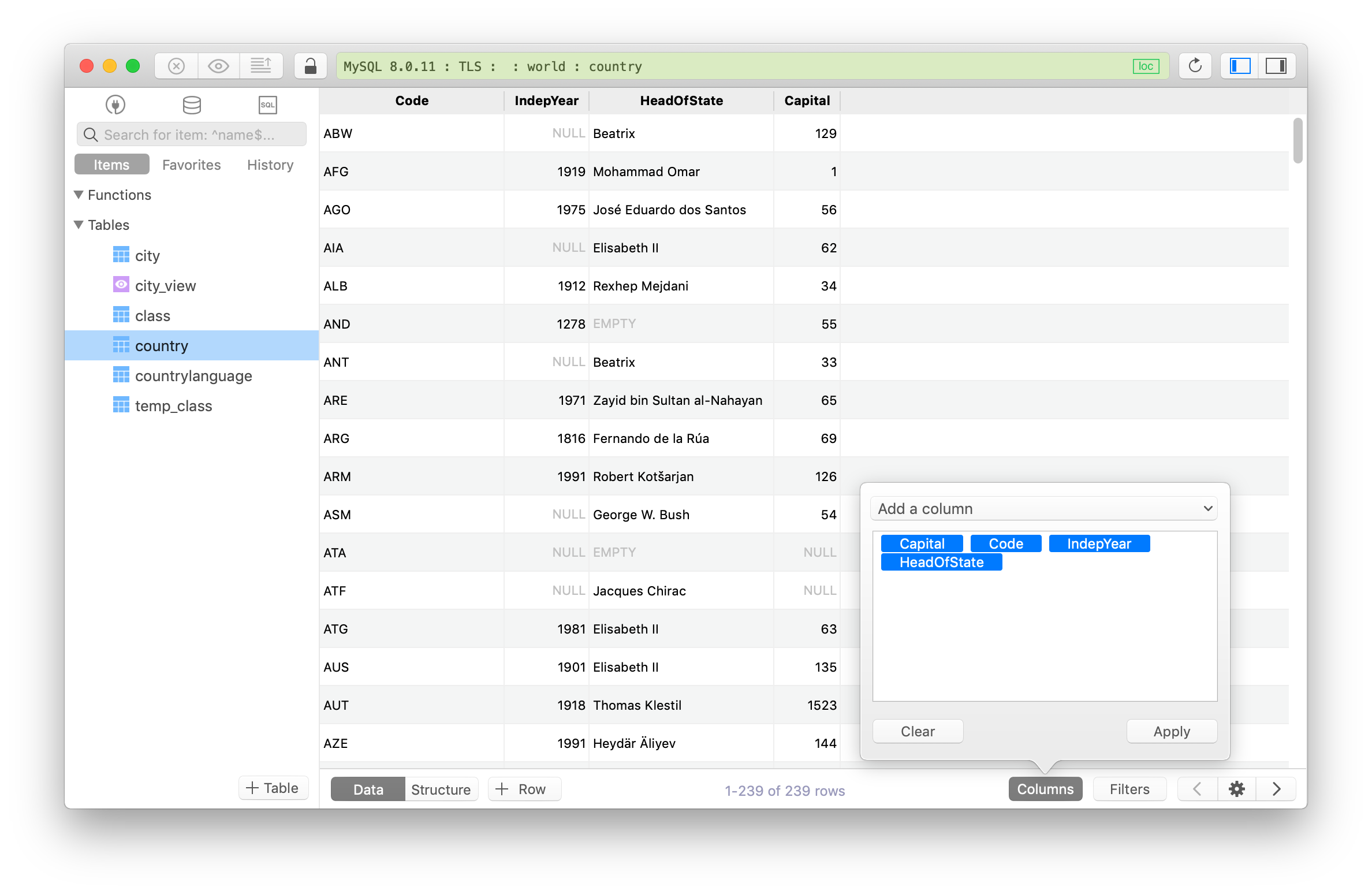

JOIN pg_attribute a ON a.attrelid = d.refobjid and a.attnum = d.refobjsubid I expanded what was done to: WITH fq_objects AS (SELECT c.oid,n.nspname || '.' ||c.relname AS fqname , The use of pg_depend catalog table was the key. I know this post is pretty old, but I found the solution by CMS to be very useful as I was looking for an automated way to link a sequence to the table AND column, and wanted to share. Pg_depend d JOIN sequences s ON s.oid = d.objid

Tables AS (SELECT oid, fqname FROM fq_objects WHERE relkind = 'r' ) Sequences AS (SELECT oid,fqname FROM fq_objects WHERE relkind = 'S'), WITH fq_objects AS (SELECT c.oid,n.nspname || '.' ||c.relname AS fqname ,įROM pg_class c JOIN pg_namespace n ON n.oid = c.relnamespace ),
#TABLEPLUS VIEW SQL PRINT SERIAL#
The where clause filters it to only include auto generated relationships, which restricts it to only display sequences created by SERIAL typed columns. This query returns all the sequence -> table dependencies in a database. The joining relationship is the link between pg_depend.objid -> pg_class.oid WHERE relkind = 'S' - which links the sequence to the join record and then pg_depend.refobjid -> pg_class.oid WHERE relkind = 'r', which links the join record to the owning relation ( table ) The information about this relationship is stored in the pg_depend catalogue table. To break the connection between the sequence and any table To set it to be linked to the table foo_table You can modify this relationship using the OWNED BY clause of the ALTER SEQUENCE commmandĪLTER SEQUENCE foo_id OWNED by foo_schema.foo_table The relationship between automatically generated sequences ( such as those created for SERIAL columns ) and the parent table is modelled by the sequence owner attribute. Type | Start | Minimum | Maximum | Increment | Cycles? | Cache To examine a particular sequence, you can then run \d : # \d lending_items_id_seq Public | stack_requests_id_seq | sequence | root Public | proxy_borrower_requests_id_seq | sequence | root Public | lending_items_id_seq | sequence | root Public | framework_users_id_seq | sequence | root Public | assignments_id_seq | sequence | root LEFT JOIN pg_catalog.pg_namespace n ON n.oid = c.relnamespaceĪND pg_catalog.pg_table_is_visible(c.oid) Pg_catalog.pg_get_userbyid(c.relowner) as "Owner" You should see something like this: # \dsĬASE c.relkind WHEN 'r' THEN 'table' WHEN 'v' THEN 'view' WHEN 'm' THEN 'materialized view' WHEN 'i' THEN 'index' WHEN 'S' THEN 'sequence' WHEN 's' THEN 'special' WHEN 'f' THEN 'foreign table' WHEN 'p' THEN 'partitioned table' WHEN 'I' THEN 'partitioned index' END as "Type", Wp_postmeta shipping ON orders.ID=shipping.post_idĮven for little things, fetching a piece of data can be way quick using TablePlus than even just looking at the order entry itself in WordPress.Launch psql with the -E flag ("echo the actual queries generated by \d and other backslash commands"), then enter the \ds command to list all sequences. Get some order/post meta for a specific set of IDS: SELECT
#TABLEPLUS VIEW SQL PRINT UPDATE#
Update order statuses in bulk: UPDATE wp_posts

Status in ('failed','complete','pending')Īnd hook in ('woocommerce_scheduled_subscription_payment') Get progress of ActionScheduler during subscription renewal periods: select status,Ĭount(*) from wp_actionscheduler_actions where Here’s the types of queries I run on a regular basis. These days I do a lot of work with WooCommerce. Here’s a screenshot of what the settings should look like. Make sure to get your IP address whitelisted, include the cert, and get the ports right. WP Engine has remote database access instructions here. Using TablePlus with WP EngineĬonnecting to a local database and most remote databases should be pretty straightforward, but there’s a few extra steps if the database is hosted with WP Engine. TablePlus is the best one one I’ve found for the Mac. Having a nice GUI to make direct database queries can be really helpful when working with a complex WordPress site.


 0 kommentar(er)
0 kommentar(er)
